PhD Proposal: Consequences of Inequality in Nepal's Healthcare Sector
VerifiedAdded on 2020/02/03
|18
|4508
|272
Project
AI Summary
This PhD proposal examines the consequences of racial and ethnic inequality within Nepal's healthcare sector, particularly in the wake of the 2015 earthquake and subsequent blockade. The research aims to identify the major reasons behind these disparities, analyze their impacts on health and social care, and recommend actions for reducing discrimination. The proposal includes a detailed literature review, exploring existing research on racial and ethnic inequalities, social determinants of health, and the specific context of Nepal. The methodology outlines an exploratory study design, emphasizing the collection of both primary and secondary data to assess the challenges faced by marginalized communities in accessing healthcare. The study's significance lies in its potential to inform government policies and interventions aimed at addressing health inequalities in Nepal. The research questions focus on identifying the causes of inequality, its impact on health and social care, and strategies for reducing discrimination. The proposal concludes with a timeline for the research and a list of references.

PhD Proposal on
“Consequences of racial and ethnic
inequality in health care sector”
“Consequences of racial and ethnic
inequality in health care sector”
Paraphrase This Document
Need a fresh take? Get an instant paraphrase of this document with our AI Paraphraser

TABLE OF CONTENTS
INTRODUCTION...........................................................................................................................3
RESEARCH AIMS & OBJECTIVES.............................................................................................4
LITERATURE REVIEW................................................................................................................7
RESEARCH METHODOLOGY...................................................................................................10
TIMESCALE.................................................................................................................................14
CONCLUSION..............................................................................................................................14
REFERENCE.................................................................................................................................16
2
INTRODUCTION...........................................................................................................................3
RESEARCH AIMS & OBJECTIVES.............................................................................................4
LITERATURE REVIEW................................................................................................................7
RESEARCH METHODOLOGY...................................................................................................10
TIMESCALE.................................................................................................................................14
CONCLUSION..............................................................................................................................14
REFERENCE.................................................................................................................................16
2
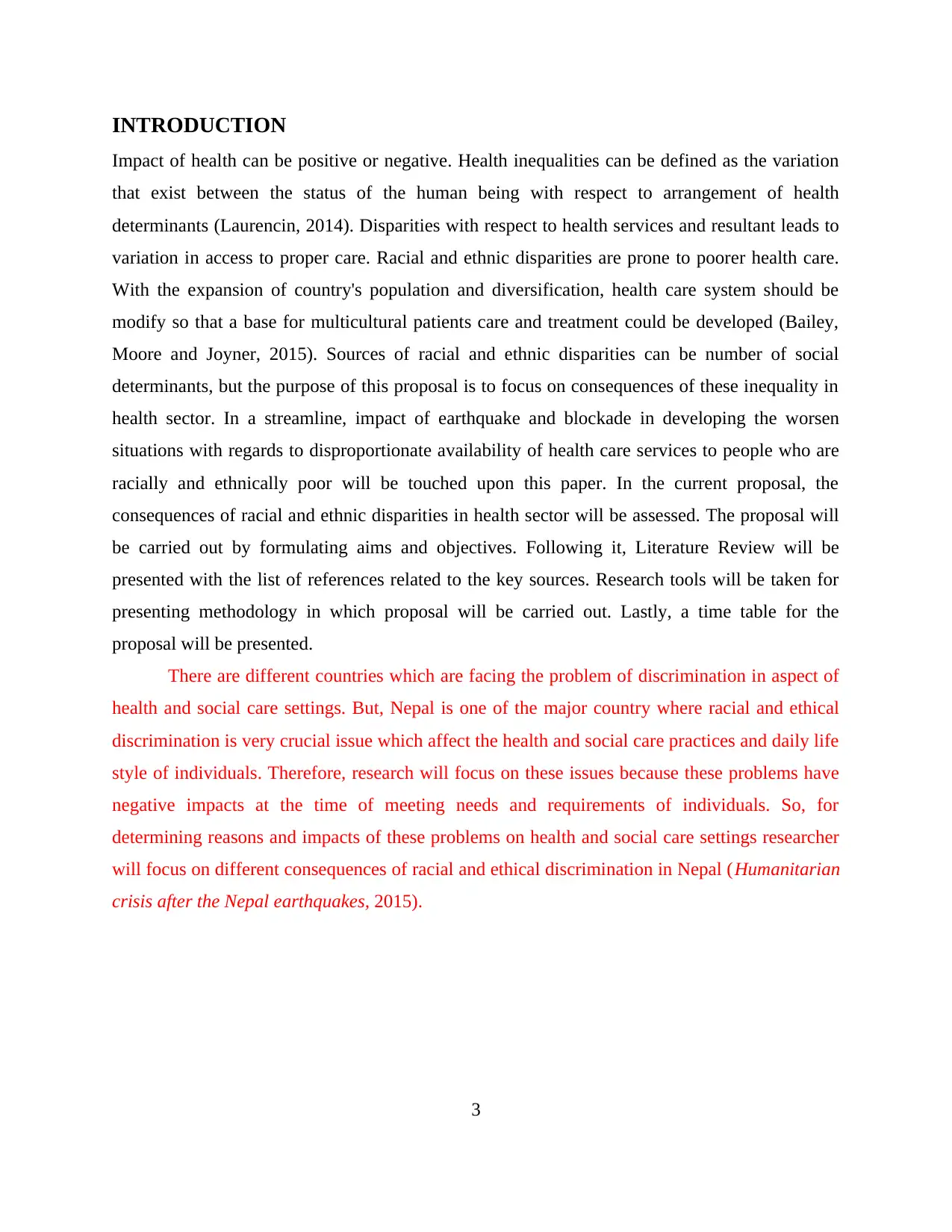
INTRODUCTION
Impact of health can be positive or negative. Health inequalities can be defined as the variation
that exist between the status of the human being with respect to arrangement of health
determinants (Laurencin, 2014). Disparities with respect to health services and resultant leads to
variation in access to proper care. Racial and ethnic disparities are prone to poorer health care.
With the expansion of country's population and diversification, health care system should be
modify so that a base for multicultural patients care and treatment could be developed (Bailey,
Moore and Joyner, 2015). Sources of racial and ethnic disparities can be number of social
determinants, but the purpose of this proposal is to focus on consequences of these inequality in
health sector. In a streamline, impact of earthquake and blockade in developing the worsen
situations with regards to disproportionate availability of health care services to people who are
racially and ethnically poor will be touched upon this paper. In the current proposal, the
consequences of racial and ethnic disparities in health sector will be assessed. The proposal will
be carried out by formulating aims and objectives. Following it, Literature Review will be
presented with the list of references related to the key sources. Research tools will be taken for
presenting methodology in which proposal will be carried out. Lastly, a time table for the
proposal will be presented.
There are different countries which are facing the problem of discrimination in aspect of
health and social care settings. But, Nepal is one of the major country where racial and ethical
discrimination is very crucial issue which affect the health and social care practices and daily life
style of individuals. Therefore, research will focus on these issues because these problems have
negative impacts at the time of meeting needs and requirements of individuals. So, for
determining reasons and impacts of these problems on health and social care settings researcher
will focus on different consequences of racial and ethical discrimination in Nepal (Humanitarian
crisis after the Nepal earthquakes, 2015).
3
Impact of health can be positive or negative. Health inequalities can be defined as the variation
that exist between the status of the human being with respect to arrangement of health
determinants (Laurencin, 2014). Disparities with respect to health services and resultant leads to
variation in access to proper care. Racial and ethnic disparities are prone to poorer health care.
With the expansion of country's population and diversification, health care system should be
modify so that a base for multicultural patients care and treatment could be developed (Bailey,
Moore and Joyner, 2015). Sources of racial and ethnic disparities can be number of social
determinants, but the purpose of this proposal is to focus on consequences of these inequality in
health sector. In a streamline, impact of earthquake and blockade in developing the worsen
situations with regards to disproportionate availability of health care services to people who are
racially and ethnically poor will be touched upon this paper. In the current proposal, the
consequences of racial and ethnic disparities in health sector will be assessed. The proposal will
be carried out by formulating aims and objectives. Following it, Literature Review will be
presented with the list of references related to the key sources. Research tools will be taken for
presenting methodology in which proposal will be carried out. Lastly, a time table for the
proposal will be presented.
There are different countries which are facing the problem of discrimination in aspect of
health and social care settings. But, Nepal is one of the major country where racial and ethical
discrimination is very crucial issue which affect the health and social care practices and daily life
style of individuals. Therefore, research will focus on these issues because these problems have
negative impacts at the time of meeting needs and requirements of individuals. So, for
determining reasons and impacts of these problems on health and social care settings researcher
will focus on different consequences of racial and ethical discrimination in Nepal (Humanitarian
crisis after the Nepal earthquakes, 2015).
3
⊘ This is a preview!⊘
Do you want full access?
Subscribe today to unlock all pages.

Trusted by 1+ million students worldwide
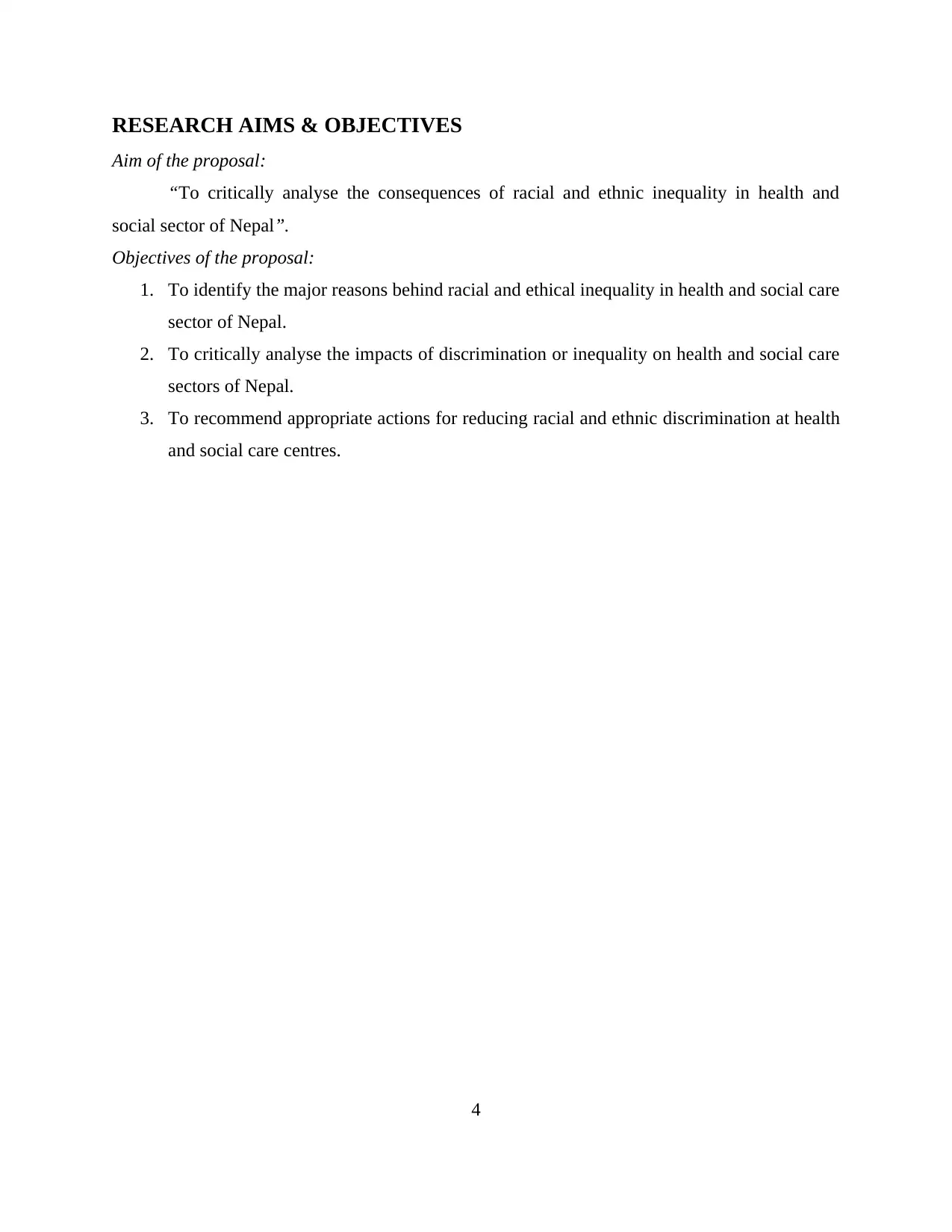
RESEARCH AIMS & OBJECTIVES
Aim of the proposal:
“To critically analyse the consequences of racial and ethnic inequality in health and
social sector of Nepal”.
Objectives of the proposal:
1. To identify the major reasons behind racial and ethical inequality in health and social care
sector of Nepal.
2. To critically analyse the impacts of discrimination or inequality on health and social care
sectors of Nepal.
3. To recommend appropriate actions for reducing racial and ethnic discrimination at health
and social care centres.
4
Aim of the proposal:
“To critically analyse the consequences of racial and ethnic inequality in health and
social sector of Nepal”.
Objectives of the proposal:
1. To identify the major reasons behind racial and ethical inequality in health and social care
sector of Nepal.
2. To critically analyse the impacts of discrimination or inequality on health and social care
sectors of Nepal.
3. To recommend appropriate actions for reducing racial and ethnic discrimination at health
and social care centres.
4
Paraphrase This Document
Need a fresh take? Get an instant paraphrase of this document with our AI Paraphraser
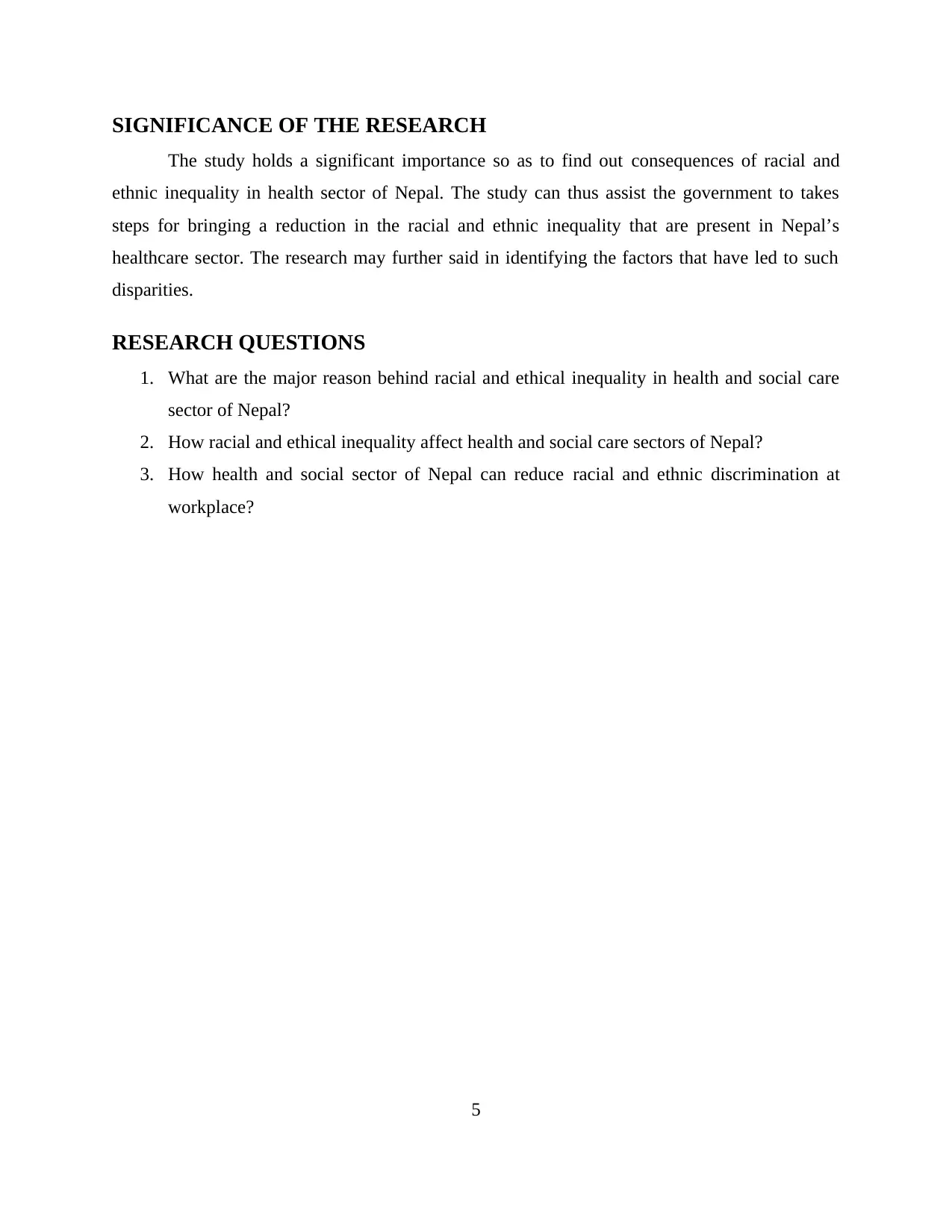
SIGNIFICANCE OF THE RESEARCH
The study holds a significant importance so as to find out consequences of racial and
ethnic inequality in health sector of Nepal. The study can thus assist the government to takes
steps for bringing a reduction in the racial and ethnic inequality that are present in Nepal’s
healthcare sector. The research may further said in identifying the factors that have led to such
disparities.
RESEARCH QUESTIONS
1. What are the major reason behind racial and ethical inequality in health and social care
sector of Nepal?
2. How racial and ethical inequality affect health and social care sectors of Nepal?
3. How health and social sector of Nepal can reduce racial and ethnic discrimination at
workplace?
5
The study holds a significant importance so as to find out consequences of racial and
ethnic inequality in health sector of Nepal. The study can thus assist the government to takes
steps for bringing a reduction in the racial and ethnic inequality that are present in Nepal’s
healthcare sector. The research may further said in identifying the factors that have led to such
disparities.
RESEARCH QUESTIONS
1. What are the major reason behind racial and ethical inequality in health and social care
sector of Nepal?
2. How racial and ethical inequality affect health and social care sectors of Nepal?
3. How health and social sector of Nepal can reduce racial and ethnic discrimination at
workplace?
5

6
⊘ This is a preview!⊘
Do you want full access?
Subscribe today to unlock all pages.

Trusted by 1+ million students worldwide
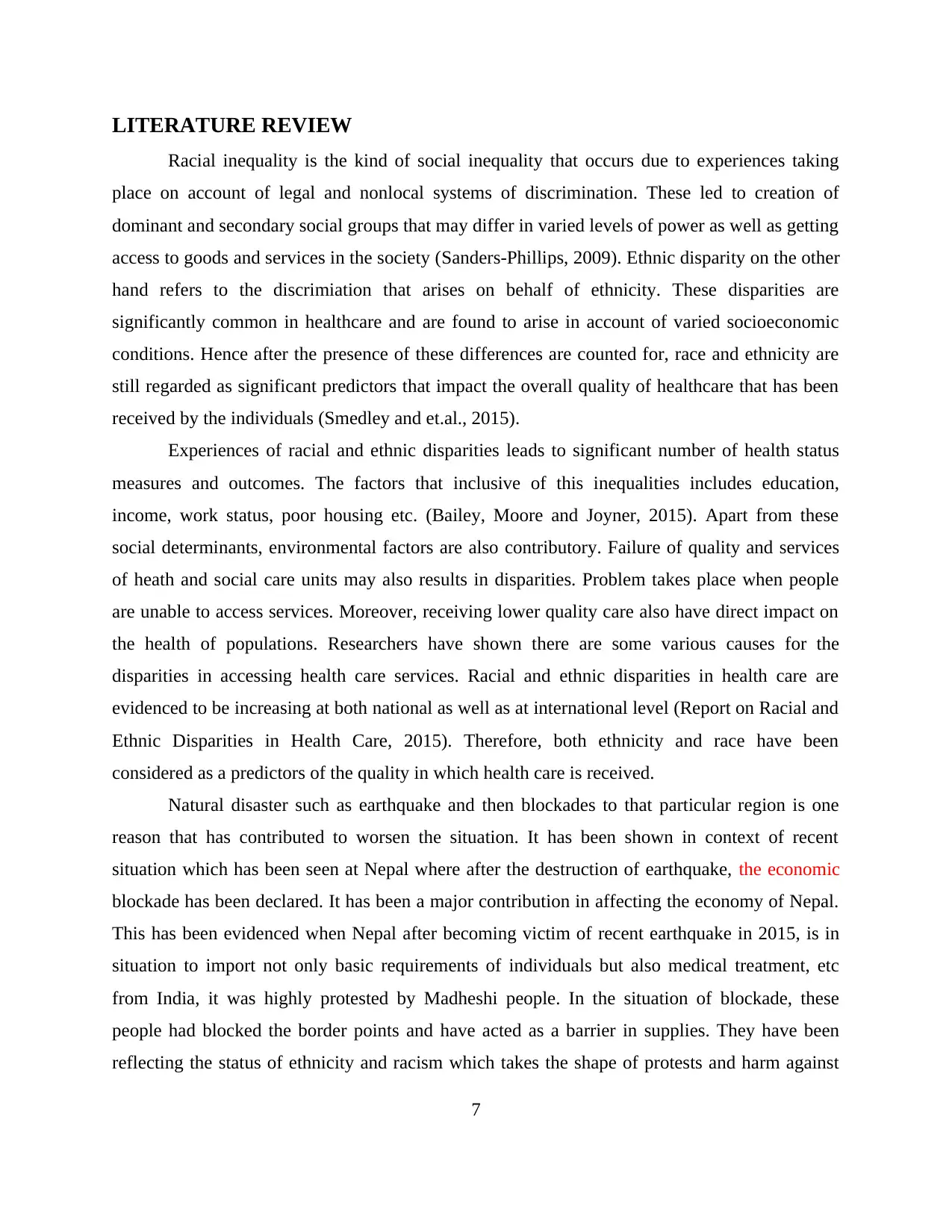
LITERATURE REVIEW
Racial inequality is the kind of social inequality that occurs due to experiences taking
place on account of legal and nonlocal systems of discrimination. These led to creation of
dominant and secondary social groups that may differ in varied levels of power as well as getting
access to goods and services in the society (Sanders-Phillips, 2009). Ethnic disparity on the other
hand refers to the discrimiation that arises on behalf of ethnicity. These disparities are
significantly common in healthcare and are found to arise in account of varied socioeconomic
conditions. Hence after the presence of these differences are counted for, race and ethnicity are
still regarded as significant predictors that impact the overall quality of healthcare that has been
received by the individuals (Smedley and et.al., 2015).
Experiences of racial and ethnic disparities leads to significant number of health status
measures and outcomes. The factors that inclusive of this inequalities includes education,
income, work status, poor housing etc. (Bailey, Moore and Joyner, 2015). Apart from these
social determinants, environmental factors are also contributory. Failure of quality and services
of heath and social care units may also results in disparities. Problem takes place when people
are unable to access services. Moreover, receiving lower quality care also have direct impact on
the health of populations. Researchers have shown there are some various causes for the
disparities in accessing health care services. Racial and ethnic disparities in health care are
evidenced to be increasing at both national as well as at international level (Report on Racial and
Ethnic Disparities in Health Care, 2015). Therefore, both ethnicity and race have been
considered as a predictors of the quality in which health care is received.
Natural disaster such as earthquake and then blockades to that particular region is one
reason that has contributed to worsen the situation. It has been shown in context of recent
situation which has been seen at Nepal where after the destruction of earthquake, the economic
blockade has been declared. It has been a major contribution in affecting the economy of Nepal.
This has been evidenced when Nepal after becoming victim of recent earthquake in 2015, is in
situation to import not only basic requirements of individuals but also medical treatment, etc
from India, it was highly protested by Madheshi people. In the situation of blockade, these
people had blocked the border points and have acted as a barrier in supplies. They have been
reflecting the status of ethnicity and racism which takes the shape of protests and harm against
7
Racial inequality is the kind of social inequality that occurs due to experiences taking
place on account of legal and nonlocal systems of discrimination. These led to creation of
dominant and secondary social groups that may differ in varied levels of power as well as getting
access to goods and services in the society (Sanders-Phillips, 2009). Ethnic disparity on the other
hand refers to the discrimiation that arises on behalf of ethnicity. These disparities are
significantly common in healthcare and are found to arise in account of varied socioeconomic
conditions. Hence after the presence of these differences are counted for, race and ethnicity are
still regarded as significant predictors that impact the overall quality of healthcare that has been
received by the individuals (Smedley and et.al., 2015).
Experiences of racial and ethnic disparities leads to significant number of health status
measures and outcomes. The factors that inclusive of this inequalities includes education,
income, work status, poor housing etc. (Bailey, Moore and Joyner, 2015). Apart from these
social determinants, environmental factors are also contributory. Failure of quality and services
of heath and social care units may also results in disparities. Problem takes place when people
are unable to access services. Moreover, receiving lower quality care also have direct impact on
the health of populations. Researchers have shown there are some various causes for the
disparities in accessing health care services. Racial and ethnic disparities in health care are
evidenced to be increasing at both national as well as at international level (Report on Racial and
Ethnic Disparities in Health Care, 2015). Therefore, both ethnicity and race have been
considered as a predictors of the quality in which health care is received.
Natural disaster such as earthquake and then blockades to that particular region is one
reason that has contributed to worsen the situation. It has been shown in context of recent
situation which has been seen at Nepal where after the destruction of earthquake, the economic
blockade has been declared. It has been a major contribution in affecting the economy of Nepal.
This has been evidenced when Nepal after becoming victim of recent earthquake in 2015, is in
situation to import not only basic requirements of individuals but also medical treatment, etc
from India, it was highly protested by Madheshi people. In the situation of blockade, these
people had blocked the border points and have acted as a barrier in supplies. They have been
reflecting the status of ethnicity and racism which takes the shape of protests and harm against
7
Paraphrase This Document
Need a fresh take? Get an instant paraphrase of this document with our AI Paraphraser

each other. The consequences of this racism and ethnicity which took place in the form of
blockade by Madheshi people in Nepal, later created the shortage of petroleum to medicines and
other relief materials which were of high need during earthquake. These consequences have
badly affected the Nepalese community (Humanitarian crisis after the Nepal earthquakes, 2015).
Different health situations in Nepal:
Review of health and social care sector of Nepal has reflected that there are different
public and private institutions of HSC which offer appropriate health care facilities of population
of nation. But, standard of health care practices is low as compare to other nations of world.
Health care practices of Nepal do not meet international standards of HSC. Including this,
findings of review has also reflected that as compare to other south Asian countries prevalence of
different kind of diseases is also very high in rural areas of Nepal. Major health issues of Nepal
include diarrhea, gastrointestinal disorders, goiter, intestinal parasites, leprosy, visceral
leishmaniasis and tuberculosis (Lindsay, 2012). But, from recent years health and social care
settings have been leading some improvement in maternal-child health. Government of nation is
talking most appropriate steps for resolving different health issues in Nepal.
Racial and ethical differences in Nepal:
Smedley and et.al, 2015 has concluded that “There are different racial and ethnic types
exist in Nepal which increases discrimination in different situations” (Smedley and et.al, 2015).
Hangen, 2007 has disclosed that “Major ethnic groups of Nepal include the Khas, the Kirat, and
the Madhesi people who live in the Terai region of Nepal” (Hangen, 2007). These groups have
developed on the basis of the different culture and values. In this groups Khas people are
included in the lower cast people and most of the health and social care settings do not provide
appropriate services to all groups of Nepal on the basis of their ethics and values. Lindsay, 2012
has concluded that “Damai, Sarki and Kami are some of the untouchable castes of the Khas
community and due to this reason these community cannot get appropriate treatment by health
care professionals” (Lindsay, 2012). Therefore, all these statements have reflected that Nepal is
facing the situation of ethical differences which affect health and social care settings of this
nation.
8
blockade by Madheshi people in Nepal, later created the shortage of petroleum to medicines and
other relief materials which were of high need during earthquake. These consequences have
badly affected the Nepalese community (Humanitarian crisis after the Nepal earthquakes, 2015).
Different health situations in Nepal:
Review of health and social care sector of Nepal has reflected that there are different
public and private institutions of HSC which offer appropriate health care facilities of population
of nation. But, standard of health care practices is low as compare to other nations of world.
Health care practices of Nepal do not meet international standards of HSC. Including this,
findings of review has also reflected that as compare to other south Asian countries prevalence of
different kind of diseases is also very high in rural areas of Nepal. Major health issues of Nepal
include diarrhea, gastrointestinal disorders, goiter, intestinal parasites, leprosy, visceral
leishmaniasis and tuberculosis (Lindsay, 2012). But, from recent years health and social care
settings have been leading some improvement in maternal-child health. Government of nation is
talking most appropriate steps for resolving different health issues in Nepal.
Racial and ethical differences in Nepal:
Smedley and et.al, 2015 has concluded that “There are different racial and ethnic types
exist in Nepal which increases discrimination in different situations” (Smedley and et.al, 2015).
Hangen, 2007 has disclosed that “Major ethnic groups of Nepal include the Khas, the Kirat, and
the Madhesi people who live in the Terai region of Nepal” (Hangen, 2007). These groups have
developed on the basis of the different culture and values. In this groups Khas people are
included in the lower cast people and most of the health and social care settings do not provide
appropriate services to all groups of Nepal on the basis of their ethics and values. Lindsay, 2012
has concluded that “Damai, Sarki and Kami are some of the untouchable castes of the Khas
community and due to this reason these community cannot get appropriate treatment by health
care professionals” (Lindsay, 2012). Therefore, all these statements have reflected that Nepal is
facing the situation of ethical differences which affect health and social care settings of this
nation.
8

Similarly, most of the research articles have also concluded that Nepal is also facing an
issue of racial inequality in different aspects and development. Smedley and et.al, 2015 has
concluded that “Nepal population consists two different racial groups Mongols and Aryans”
(Smedley and et.al, 2015). In these racial groups 80% population of Nepal belong to Mongol and
20% are associated with Aryans (Hangen, 2007). Therefore, these are also considered as major
base for racial inequality in Nepal.
Nepal's issue on medicine and nutrition crises due to blockade:
Due to the Earthquake or natural disaster, Nepal is facing the problem of economic
blockade which affect the movement of goods and services from one place to another. Due to the
economic blockage country was facing problem in getting medicines basic necessities for people.
Along with this, government of nation was not capable to give nutritious food to all required
people due to the economic blockade (Humanitarian crisis after the Nepal earthquakes, 2015).
At an international level, this is very common in UK as well, where minorities groups are
unable to access the services properly. Patients are either not able to communicate to health care
professionals or remain uninformed. Ethnic minority communities and linguistic groups in UK
are thereby not able to achieve equitable access. In a similar fashion, when taking about national
level, Asia has also been facing the same issue. Nepal, which is evidenced with recent
humanitarian crisis of Earthquake in 2015, had faced pathetic situation (Burnett, 2015). There are
various remote and rural areas where access and availability of health services remain
challenging. Therefore, the rationale behind current proposal is to identify the consequences of
racial and ethical disparities in health sector.
9
issue of racial inequality in different aspects and development. Smedley and et.al, 2015 has
concluded that “Nepal population consists two different racial groups Mongols and Aryans”
(Smedley and et.al, 2015). In these racial groups 80% population of Nepal belong to Mongol and
20% are associated with Aryans (Hangen, 2007). Therefore, these are also considered as major
base for racial inequality in Nepal.
Nepal's issue on medicine and nutrition crises due to blockade:
Due to the Earthquake or natural disaster, Nepal is facing the problem of economic
blockade which affect the movement of goods and services from one place to another. Due to the
economic blockage country was facing problem in getting medicines basic necessities for people.
Along with this, government of nation was not capable to give nutritious food to all required
people due to the economic blockade (Humanitarian crisis after the Nepal earthquakes, 2015).
At an international level, this is very common in UK as well, where minorities groups are
unable to access the services properly. Patients are either not able to communicate to health care
professionals or remain uninformed. Ethnic minority communities and linguistic groups in UK
are thereby not able to achieve equitable access. In a similar fashion, when taking about national
level, Asia has also been facing the same issue. Nepal, which is evidenced with recent
humanitarian crisis of Earthquake in 2015, had faced pathetic situation (Burnett, 2015). There are
various remote and rural areas where access and availability of health services remain
challenging. Therefore, the rationale behind current proposal is to identify the consequences of
racial and ethical disparities in health sector.
9
⊘ This is a preview!⊘
Do you want full access?
Subscribe today to unlock all pages.

Trusted by 1+ million students worldwide
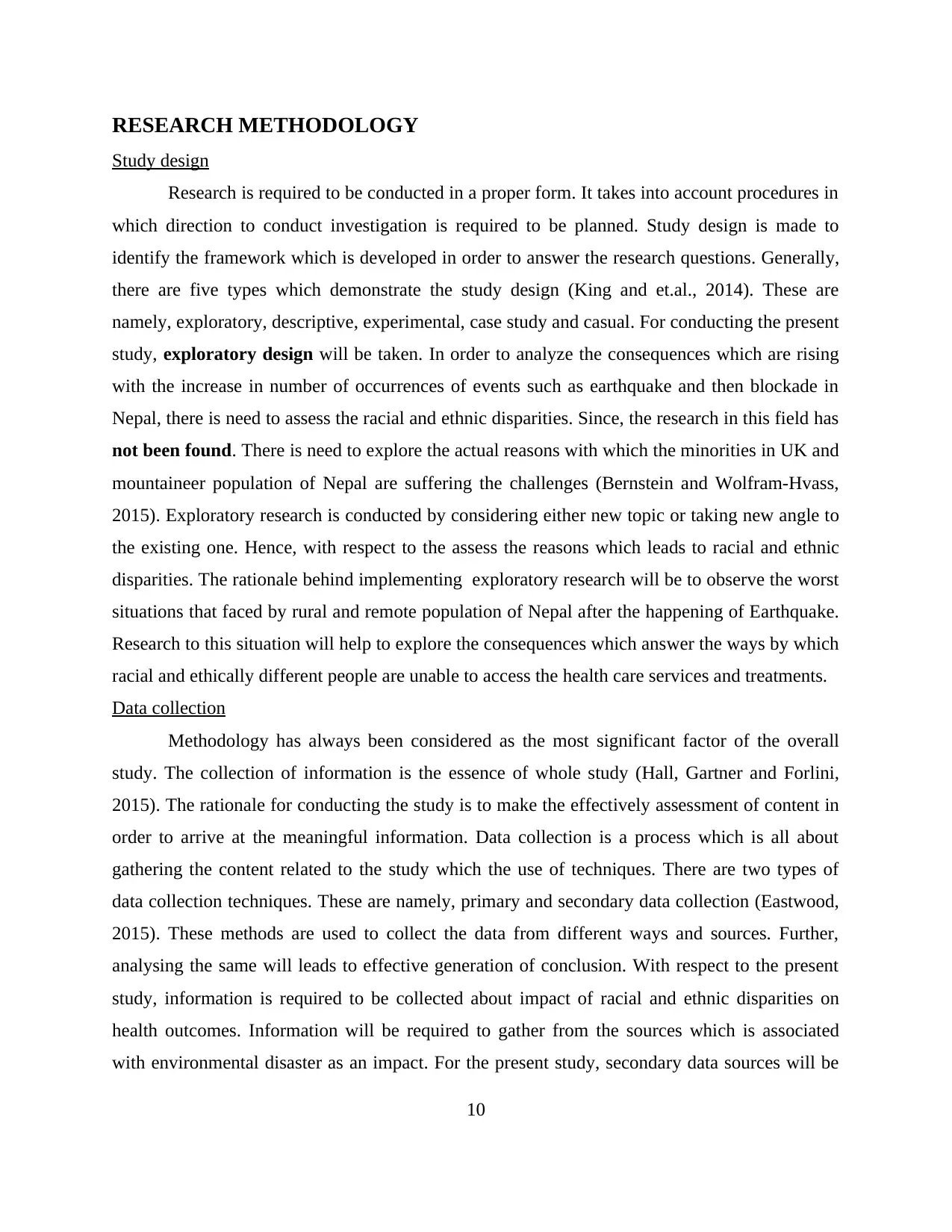
RESEARCH METHODOLOGY
Study design
Research is required to be conducted in a proper form. It takes into account procedures in
which direction to conduct investigation is required to be planned. Study design is made to
identify the framework which is developed in order to answer the research questions. Generally,
there are five types which demonstrate the study design (King and et.al., 2014). These are
namely, exploratory, descriptive, experimental, case study and casual. For conducting the present
study, exploratory design will be taken. In order to analyze the consequences which are rising
with the increase in number of occurrences of events such as earthquake and then blockade in
Nepal, there is need to assess the racial and ethnic disparities. Since, the research in this field has
not been found. There is need to explore the actual reasons with which the minorities in UK and
mountaineer population of Nepal are suffering the challenges (Bernstein and Wolfram-Hvass,
2015). Exploratory research is conducted by considering either new topic or taking new angle to
the existing one. Hence, with respect to the assess the reasons which leads to racial and ethnic
disparities. The rationale behind implementing exploratory research will be to observe the worst
situations that faced by rural and remote population of Nepal after the happening of Earthquake.
Research to this situation will help to explore the consequences which answer the ways by which
racial and ethically different people are unable to access the health care services and treatments.
Data collection
Methodology has always been considered as the most significant factor of the overall
study. The collection of information is the essence of whole study (Hall, Gartner and Forlini,
2015). The rationale for conducting the study is to make the effectively assessment of content in
order to arrive at the meaningful information. Data collection is a process which is all about
gathering the content related to the study which the use of techniques. There are two types of
data collection techniques. These are namely, primary and secondary data collection (Eastwood,
2015). These methods are used to collect the data from different ways and sources. Further,
analysing the same will leads to effective generation of conclusion. With respect to the present
study, information is required to be collected about impact of racial and ethnic disparities on
health outcomes. Information will be required to gather from the sources which is associated
with environmental disaster as an impact. For the present study, secondary data sources will be
10
Study design
Research is required to be conducted in a proper form. It takes into account procedures in
which direction to conduct investigation is required to be planned. Study design is made to
identify the framework which is developed in order to answer the research questions. Generally,
there are five types which demonstrate the study design (King and et.al., 2014). These are
namely, exploratory, descriptive, experimental, case study and casual. For conducting the present
study, exploratory design will be taken. In order to analyze the consequences which are rising
with the increase in number of occurrences of events such as earthquake and then blockade in
Nepal, there is need to assess the racial and ethnic disparities. Since, the research in this field has
not been found. There is need to explore the actual reasons with which the minorities in UK and
mountaineer population of Nepal are suffering the challenges (Bernstein and Wolfram-Hvass,
2015). Exploratory research is conducted by considering either new topic or taking new angle to
the existing one. Hence, with respect to the assess the reasons which leads to racial and ethnic
disparities. The rationale behind implementing exploratory research will be to observe the worst
situations that faced by rural and remote population of Nepal after the happening of Earthquake.
Research to this situation will help to explore the consequences which answer the ways by which
racial and ethically different people are unable to access the health care services and treatments.
Data collection
Methodology has always been considered as the most significant factor of the overall
study. The collection of information is the essence of whole study (Hall, Gartner and Forlini,
2015). The rationale for conducting the study is to make the effectively assessment of content in
order to arrive at the meaningful information. Data collection is a process which is all about
gathering the content related to the study which the use of techniques. There are two types of
data collection techniques. These are namely, primary and secondary data collection (Eastwood,
2015). These methods are used to collect the data from different ways and sources. Further,
analysing the same will leads to effective generation of conclusion. With respect to the present
study, information is required to be collected about impact of racial and ethnic disparities on
health outcomes. Information will be required to gather from the sources which is associated
with environmental disaster as an impact. For the present study, secondary data sources will be
10
Paraphrase This Document
Need a fresh take? Get an instant paraphrase of this document with our AI Paraphraser
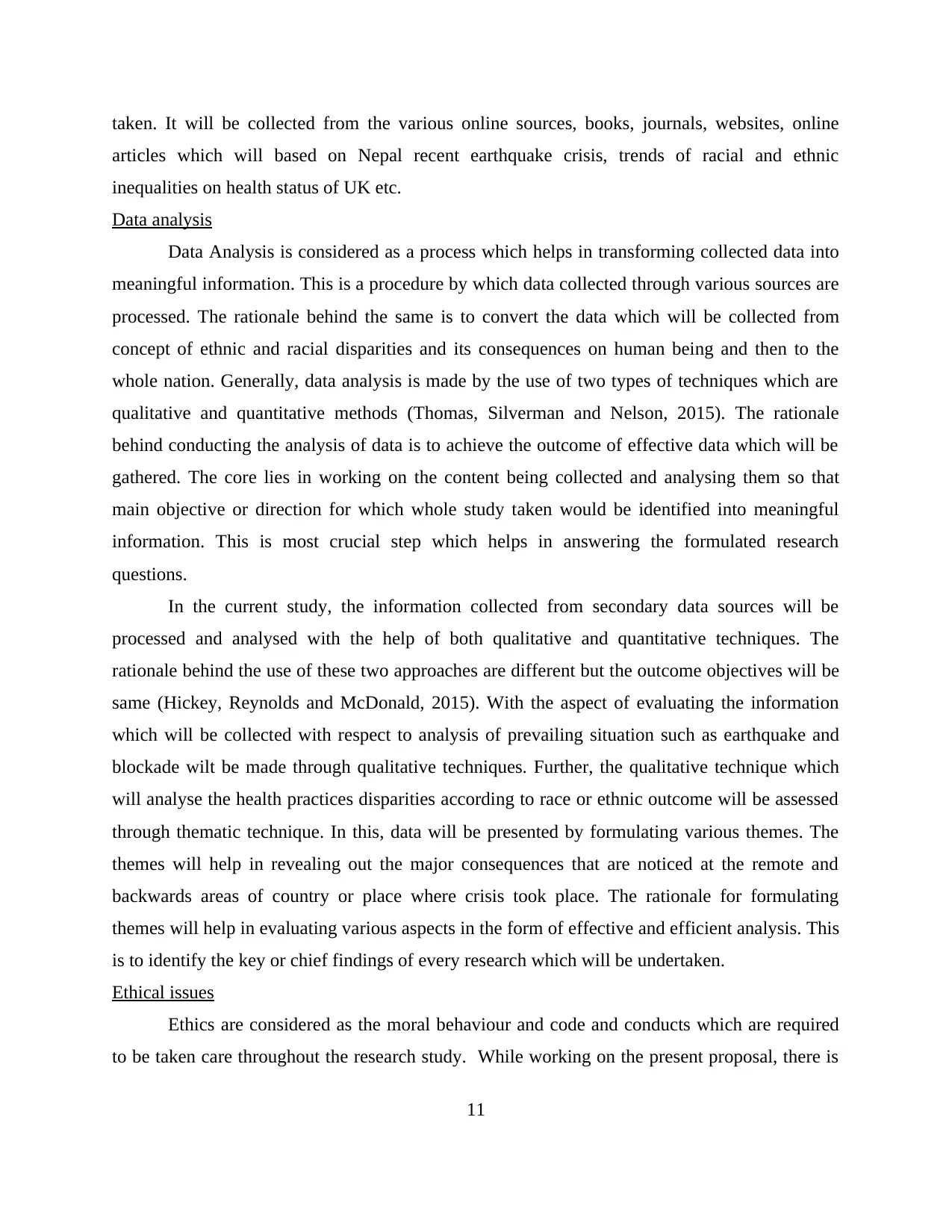
taken. It will be collected from the various online sources, books, journals, websites, online
articles which will based on Nepal recent earthquake crisis, trends of racial and ethnic
inequalities on health status of UK etc.
Data analysis
Data Analysis is considered as a process which helps in transforming collected data into
meaningful information. This is a procedure by which data collected through various sources are
processed. The rationale behind the same is to convert the data which will be collected from
concept of ethnic and racial disparities and its consequences on human being and then to the
whole nation. Generally, data analysis is made by the use of two types of techniques which are
qualitative and quantitative methods (Thomas, Silverman and Nelson, 2015). The rationale
behind conducting the analysis of data is to achieve the outcome of effective data which will be
gathered. The core lies in working on the content being collected and analysing them so that
main objective or direction for which whole study taken would be identified into meaningful
information. This is most crucial step which helps in answering the formulated research
questions.
In the current study, the information collected from secondary data sources will be
processed and analysed with the help of both qualitative and quantitative techniques. The
rationale behind the use of these two approaches are different but the outcome objectives will be
same (Hickey, Reynolds and McDonald, 2015). With the aspect of evaluating the information
which will be collected with respect to analysis of prevailing situation such as earthquake and
blockade wilt be made through qualitative techniques. Further, the qualitative technique which
will analyse the health practices disparities according to race or ethnic outcome will be assessed
through thematic technique. In this, data will be presented by formulating various themes. The
themes will help in revealing out the major consequences that are noticed at the remote and
backwards areas of country or place where crisis took place. The rationale for formulating
themes will help in evaluating various aspects in the form of effective and efficient analysis. This
is to identify the key or chief findings of every research which will be undertaken.
Ethical issues
Ethics are considered as the moral behaviour and code and conducts which are required
to be taken care throughout the research study. While working on the present proposal, there is
11
articles which will based on Nepal recent earthquake crisis, trends of racial and ethnic
inequalities on health status of UK etc.
Data analysis
Data Analysis is considered as a process which helps in transforming collected data into
meaningful information. This is a procedure by which data collected through various sources are
processed. The rationale behind the same is to convert the data which will be collected from
concept of ethnic and racial disparities and its consequences on human being and then to the
whole nation. Generally, data analysis is made by the use of two types of techniques which are
qualitative and quantitative methods (Thomas, Silverman and Nelson, 2015). The rationale
behind conducting the analysis of data is to achieve the outcome of effective data which will be
gathered. The core lies in working on the content being collected and analysing them so that
main objective or direction for which whole study taken would be identified into meaningful
information. This is most crucial step which helps in answering the formulated research
questions.
In the current study, the information collected from secondary data sources will be
processed and analysed with the help of both qualitative and quantitative techniques. The
rationale behind the use of these two approaches are different but the outcome objectives will be
same (Hickey, Reynolds and McDonald, 2015). With the aspect of evaluating the information
which will be collected with respect to analysis of prevailing situation such as earthquake and
blockade wilt be made through qualitative techniques. Further, the qualitative technique which
will analyse the health practices disparities according to race or ethnic outcome will be assessed
through thematic technique. In this, data will be presented by formulating various themes. The
themes will help in revealing out the major consequences that are noticed at the remote and
backwards areas of country or place where crisis took place. The rationale for formulating
themes will help in evaluating various aspects in the form of effective and efficient analysis. This
is to identify the key or chief findings of every research which will be undertaken.
Ethical issues
Ethics are considered as the moral behaviour and code and conducts which are required
to be taken care throughout the research study. While working on the present proposal, there is
11
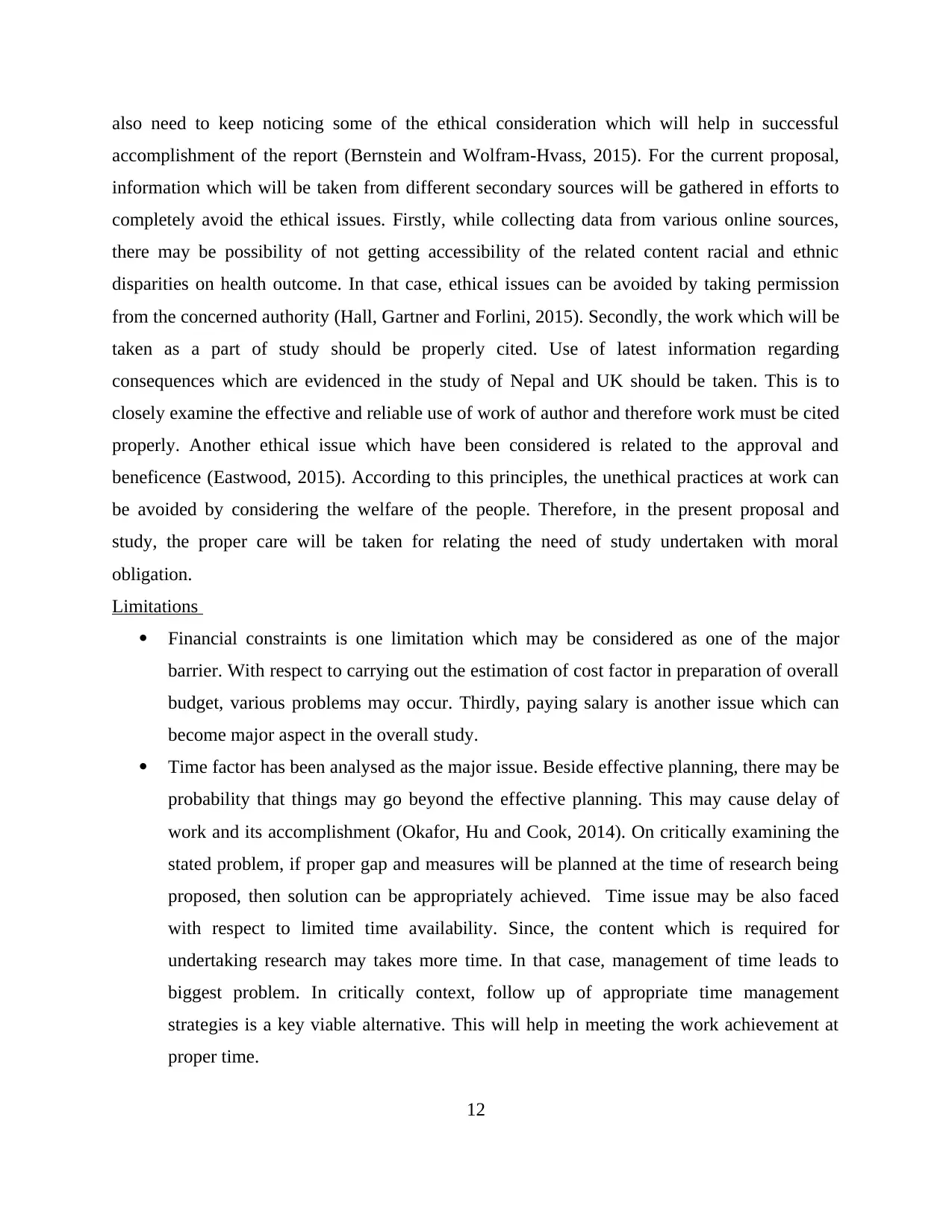
also need to keep noticing some of the ethical consideration which will help in successful
accomplishment of the report (Bernstein and Wolfram-Hvass, 2015). For the current proposal,
information which will be taken from different secondary sources will be gathered in efforts to
completely avoid the ethical issues. Firstly, while collecting data from various online sources,
there may be possibility of not getting accessibility of the related content racial and ethnic
disparities on health outcome. In that case, ethical issues can be avoided by taking permission
from the concerned authority (Hall, Gartner and Forlini, 2015). Secondly, the work which will be
taken as a part of study should be properly cited. Use of latest information regarding
consequences which are evidenced in the study of Nepal and UK should be taken. This is to
closely examine the effective and reliable use of work of author and therefore work must be cited
properly. Another ethical issue which have been considered is related to the approval and
beneficence (Eastwood, 2015). According to this principles, the unethical practices at work can
be avoided by considering the welfare of the people. Therefore, in the present proposal and
study, the proper care will be taken for relating the need of study undertaken with moral
obligation.
Limitations
Financial constraints is one limitation which may be considered as one of the major
barrier. With respect to carrying out the estimation of cost factor in preparation of overall
budget, various problems may occur. Thirdly, paying salary is another issue which can
become major aspect in the overall study.
Time factor has been analysed as the major issue. Beside effective planning, there may be
probability that things may go beyond the effective planning. This may cause delay of
work and its accomplishment (Okafor, Hu and Cook, 2014). On critically examining the
stated problem, if proper gap and measures will be planned at the time of research being
proposed, then solution can be appropriately achieved. Time issue may be also faced
with respect to limited time availability. Since, the content which is required for
undertaking research may takes more time. In that case, management of time leads to
biggest problem. In critically context, follow up of appropriate time management
strategies is a key viable alternative. This will help in meeting the work achievement at
proper time.
12
accomplishment of the report (Bernstein and Wolfram-Hvass, 2015). For the current proposal,
information which will be taken from different secondary sources will be gathered in efforts to
completely avoid the ethical issues. Firstly, while collecting data from various online sources,
there may be possibility of not getting accessibility of the related content racial and ethnic
disparities on health outcome. In that case, ethical issues can be avoided by taking permission
from the concerned authority (Hall, Gartner and Forlini, 2015). Secondly, the work which will be
taken as a part of study should be properly cited. Use of latest information regarding
consequences which are evidenced in the study of Nepal and UK should be taken. This is to
closely examine the effective and reliable use of work of author and therefore work must be cited
properly. Another ethical issue which have been considered is related to the approval and
beneficence (Eastwood, 2015). According to this principles, the unethical practices at work can
be avoided by considering the welfare of the people. Therefore, in the present proposal and
study, the proper care will be taken for relating the need of study undertaken with moral
obligation.
Limitations
Financial constraints is one limitation which may be considered as one of the major
barrier. With respect to carrying out the estimation of cost factor in preparation of overall
budget, various problems may occur. Thirdly, paying salary is another issue which can
become major aspect in the overall study.
Time factor has been analysed as the major issue. Beside effective planning, there may be
probability that things may go beyond the effective planning. This may cause delay of
work and its accomplishment (Okafor, Hu and Cook, 2014). On critically examining the
stated problem, if proper gap and measures will be planned at the time of research being
proposed, then solution can be appropriately achieved. Time issue may be also faced
with respect to limited time availability. Since, the content which is required for
undertaking research may takes more time. In that case, management of time leads to
biggest problem. In critically context, follow up of appropriate time management
strategies is a key viable alternative. This will help in meeting the work achievement at
proper time.
12
⊘ This is a preview!⊘
Do you want full access?
Subscribe today to unlock all pages.

Trusted by 1+ million students worldwide
1 out of 18
Related Documents
Your All-in-One AI-Powered Toolkit for Academic Success.
+13062052269
info@desklib.com
Available 24*7 on WhatsApp / Email
![[object Object]](/_next/static/media/star-bottom.7253800d.svg)
Unlock your academic potential
Copyright © 2020–2025 A2Z Services. All Rights Reserved. Developed and managed by ZUCOL.





